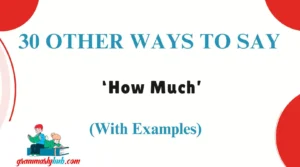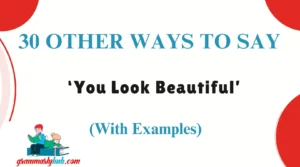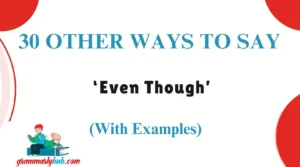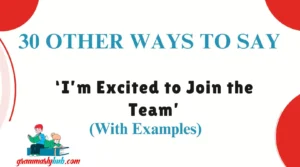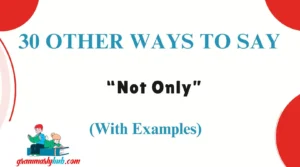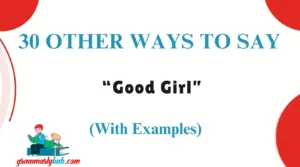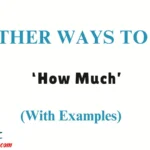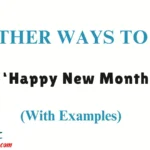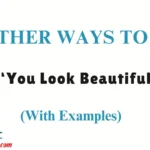When it comes to expressing information or making a point, the words we choose can truly shape the message we’re sending. Sometimes, using the same phrase repeatedly can make our communication feel robotic or detached. Finding alternative ways to say common phrases like “the text states” adds warmth, clarity, and even a bit of personality to your writing or speech.
These alternatives not only make your message more engaging but also help you connect more deeply with your audience. In this article, we’ll explore 30 different ways to say “the text states”, with examples and scenarios to guide you through each one, helping you select the perfect alternative for every occasion.
What Does “The Text States” Mean?
“The text states” is typically used to indicate that something is being referenced or quoted directly from a written source. It suggests that the following information or idea can be found in the text you’re referring to, whether it’s an article, essay, book, or any other form of written communication. It’s a straightforward way of presenting information that originates from a specific source.
When to Use “The Text States”
You would use “the text states” when you are citing a particular detail, piece of information, or idea from a written source. It’s often used in academic writing, formal discussions, or when you want to give authority to the information presented by showing that it is grounded in written material.
Is It Professional/Polite to Say “The Text States”?
Yes, “the text states” is considered both professional and polite in formal writing or discussions. However, it might sound a little dry or mechanical in more informal contexts, where alternative phrasing could make your language sound more conversational or approachable.
Pros and Cons of Using “The Text States”
Pros:
- Clarity: It provides a clear indication that the information is coming directly from a written source.
- Formality: It maintains a formal tone suitable for academic or professional writing.
Cons:
- Repetition: Overusing it can make your writing sound redundant or stiff.
- Lack of personality: It doesn’t allow for much creativity or engagement with the reader.
“The Text States”Synonyms
- The author explains
- The passage suggests
- The article mentions
- The writer conveys
- The excerpt reveals
- The source claims
- The paragraph shows
- The document outlines
- The section describes
- The content presents
- The statement implies
- The evidence demonstrates
- The literature notes
- The source provides
- The reading indicates
- The information details
- The commentary highlights
- The work explores
- The material clarifies
- The narrative reflects
- The text portrays
- The piece informs
- The article details
- The reference acknowledges
- The chapter includes
- The report confirms
- The explanation gives
- The essay argues
- The selection supports
- The research states
1. The Text Mentions
Definition: “The text mentions” indicates that a particular point or piece of information is brought up in the text.
Detailed Explanation: This alternative is great for drawing attention to something that is briefly referenced without going into much detail.
Scenario Example: “The text mentions the benefits of early morning exercise.”
Worst Use: Using “the text mentions” when providing a detailed explanation or argument—this would be vague.
Tone: Neutral, somewhat formal.
2. The Text Explains
Definition: “The text explains” suggests that the text is providing an explanation or clarification of a concept.
Detailed Explanation: This alternative works well when you want to emphasize that the text elaborates on a particular subject.
Scenario Example: “The text explains the reasons behind global warming.”
Worst Use: When the text simply mentions something without elaborating on it.
Tone: Informative, neutral.
3. The Text Reveals
Definition: “The text reveals” implies that the text uncovers or discloses a fact or detail.
Detailed Explanation: This phrasing adds a sense of discovery or new information, which can be useful in creating an engaging narrative.
Scenario Example: “The text reveals the author’s personal perspective on climate change.”
Worst Use: When the information presented is neither surprising nor new.
Tone: Slightly dramatic, intriguing.
4. The Text Indicates
Definition: “The text indicates” means that the text provides a clue or sign about something.
Detailed Explanation: This is a more formal, neutral way of referring to the information presented in a text.
Scenario Example: “The text indicates that the character’s motivations are driven by fear.”
Worst Use: Using “the text indicates” when the information is explicit and clear.
Tone: Neutral, formal.
5. The Text Suggests
Definition: “The text suggests” implies that the text is putting forth an idea or recommendation.
Detailed Explanation: This is a gentler alternative to stating something as a fact. It’s often used when the text proposes an idea without strong evidence.
Scenario Example: “The text suggests that individuals should take action to reduce waste.”
Worst Use: When the text makes a definitive statement or claim.
Tone: Slightly tentative, polite.
6. The Text Points Out
Definition: “The text points out” highlights that the text is bringing attention to a specific detail or fact.
Detailed Explanation: This alternative is excellent for directing the reader to something worth noticing in the text.
Scenario Example: “The text points out the significance of family traditions in shaping identity.”
Worst Use: When the information is implied rather than explicitly pointed out.
Tone: Clear, neutral.
7. The Text Describes
Definition: “The text describes” means that the text is providing a detailed portrayal or account of something.
Detailed Explanation: This alternative is useful when the text is painting a vivid picture or providing in-depth details.
Scenario Example: “The text describes the town as a bustling, vibrant community.”
Worst Use: When the text does not provide much detail.
Tone: Descriptive, neutral.
8. The Text Highlights
Definition: “The text highlights” suggests that the text is emphasizing something of importance.
Detailed Explanation: This is a great choice when the text is focused on a particular point that needs to stand out.
Scenario Example: “The text highlights the importance of mental health in schools.”
Worst Use: When the text is too general or does not focus on a specific point.
Tone: Strong, focused.
9. The Text Clarifies
Definition: “The text clarifies” means that the text makes something easier to understand or more transparent.
Detailed Explanation: This phrase is ideal when you want to express that the text makes a complicated idea simpler or clearer.
Scenario Example: “The text clarifies the process of obtaining a visa.”
Worst Use: When the text doesn’t simplify or explain anything.
Tone: Educational, neutral.
10. The Text States
Definition: “The text states” is used to directly quote or reference something from a written text.
Detailed Explanation: It’s straightforward and formal, often used in academic or professional settings to refer to specific content in a document.
Scenario Example: “The text states that global warming is accelerating.”
Worst Use: When you need a less formal or more dynamic phrase.
Tone: Formal, neutral.
11. The Passage Suggests
Definition: Implies the written passage offers an idea or theory subtly.
Detailed Explanation: Ideal when the source is not direct but offers insight or interpretation.
Scenario Example: “The passage suggests the character is hiding something.”
Worst Use: When quoting an obvious fact or statement.
Tone: Reflective, analytical.
12. According to the Text
Definition: Shows the information is sourced from a specific text.
Detailed Explanation: A solid academic alternative that indicates factual sourcing.
Scenario Example: “According to the text, sleep is essential for brain function.”
Worst Use: In creative writing or casual conversations.
Tone: Formal, direct.
13. The Reading Demonstrates
Definition: Suggests the text is providing evidence or support for something.
Detailed Explanation: Use when the text clearly proves or shows an idea in action.
Scenario Example: “The reading demonstrates how teamwork enhances success.”
Worst Use: When the text is speculative or lacks clear proof.
Tone: Confident, assertive.
14. The Passage Emphasizes
Definition: Highlights that a specific point is strongly featured in the text.
Detailed Explanation: Works well when the author clearly wants readers to focus on a point.
Scenario Example: “The passage emphasizes the need for clean energy.”
Worst Use: When the text only briefly mentions a point.
Tone: Strong, instructive.
15. The Author Argues
Definition: Indicates the author is making a case or persuasive statement.
Detailed Explanation: Great for analyzing opinion-based or persuasive writing.
Scenario Example: “The author argues that stricter laws reduce crime rates.”
Worst Use: When the content is narrative or descriptive, not persuasive.
Tone: Debative, critical.
16. The Author Illustrates
Definition: Shows how the author provides examples or visual language.
Detailed Explanation: Use when the text provides a vivid example or scenario.
Scenario Example: “The author illustrates the beauty of the landscape through imagery.”
Worst Use: When the text is technical or lacks descriptive writing.
Tone: Visual, expressive.
17. The Source Notes
Definition: A concise way to cite where an idea came from.
Detailed Explanation: Best used in research-heavy writing or professional presentations.
Scenario Example: “The source notes that nearly 80% of users prefer mobile browsing.”
Worst Use: In casual or conversational writing.
Tone: Formal, concise.
18. The Material Covers
Definition: Suggests the text deals with or addresses a topic.
Detailed Explanation: Use this when summarizing what a document or lesson is about.
Scenario Example: “The material covers the basics of digital marketing.”
Worst Use: When referencing only a small detail.
Tone: Broad, informative.
19. The Passage Relates
Definition: Shows a connection or relevance between text parts.
Detailed Explanation: Useful when tying a topic to broader themes or comparisons.
Scenario Example: “The passage relates the character’s fear to past trauma.”
Worst Use: When referencing something isolated or fact-based.
Tone: Thoughtful, connective.
20. As Stated in the Text
Definition: Refers to a specific quote or paraphrased line from the source.
Detailed Explanation: Useful for directly linking your argument to the source material.
Scenario Example: “As stated in the text, success often requires sacrifice.”
Worst Use: When no textual support is present.
Tone: Formal, supportive.
21. The Text Illustrates
Definition: Shows a vivid example or clear picture of an idea.
Detailed Explanation: Use when the text paints a scene or clarifies a concept through visuals or metaphors.
Scenario Example: “The text illustrates the isolation felt by the main character.”
Worst Use: When the writing is too abstract or dry.
Tone: Engaging, illustrative.
22. The Text Portrays
Definition: Shows how the text depicts a scene, person, or emotion.
Detailed Explanation: Ideal for literary analysis or character evaluation.
Scenario Example: “The text portrays the king as both wise and ruthless.”
Worst Use: In factual or statistical writing.
Tone: Creative, analytical.
23. The Passage Depicts
Definition: A formal way to say that something is shown or described in the writing.
Detailed Explanation: Especially effective for narratives or descriptive writing.
Scenario Example: “The passage depicts a war-torn city filled with silence.”
Worst Use: When only basic or brief mention is made.
Tone: Artistic, reflective.
24. The Text Reflects
Definition: Indicates the writing mirrors a thought or emotion.
Detailed Explanation: Best when describing emotional tone or personal perspective.
Scenario Example: “The text reflects the growing frustration of the community.”
Worst Use: When talking about facts or straightforward information.
Tone: Empathetic, introspective.
25. The Text Informs
Definition: The writing is educating or providing facts to the reader.
Detailed Explanation: Excellent for informative content or tutorials.
Scenario Example: “The text informs readers about proper nutrition practices.”
Worst Use: In stories or opinion pieces.
Tone: Direct, instructional.
26. The Author Outlines
Definition: Indicates a structured explanation or summary.
Detailed Explanation: Great for outlining steps, processes, or plans.
Scenario Example: “The author outlines five ways to reduce plastic use.”
Worst Use: When the writing is poetic or unstructured.
Tone: Methodical, clear.
27. The Content Shows
Definition: Suggests the material presents or makes visible an idea.
Detailed Explanation: Flexible for both facts and storytelling.
Scenario Example: “The content shows how habits influence results.”
Worst Use: Too vague for analytical writing.
Tone: Friendly, general.
28. The Source Shows
Definition: Similar to the above, but more research-oriented.
Detailed Explanation: Perfect for articles, papers, and research summaries.
Scenario Example: “The source shows the direct correlation between stress and sleep.”
Worst Use: In creative writing.
Tone: Academic, straightforward.
29. The Text Brings Forward
Definition: Indicates the text is presenting an idea with importance.
Detailed Explanation: Use when something is introduced thoughtfully or intentionally.
Scenario Example: “The text brings forward the need for inclusive education.”
Worst Use: When the point is subtle or minor.
Tone: Progressive, intentional.
30. The Text Speaks To
Definition: Implies the writing connects with or addresses an issue deeply.
Detailed Explanation: Emotionally resonant and conversational, ideal for essays or speeches.
Scenario Example: “The text speaks to the struggles of balancing work and family.”
Worst Use: For cold, analytical content.
Tone: Warm, heartfelt.
🟨 Conclusion
Whether you’re crafting an essay, article, or reflection, having a broad vocabulary for expressing what a text conveys helps you write with clarity, warmth, and professionalism. These 30 alternatives not only improve readability but also help tailor your message to different contexts—academic, emotional, or persuasive. Choose the phrase that best suits your tone, the purpose of your content, and the level of engagement you want from your audience. The goal is always to connect thoughtfully while communicating effectively.
✅ FAQs
1. Can I use these alternatives in academic writing?
Absolutely. Many of these phrases are perfectly suited for essays, research papers, and formal reports. Just be sure to match the tone and intent of the sentence with the appropriate phrase, such as using “According to the text” or “The passage suggests” in analytical writing.
2. Are these expressions suitable for creative writing too?
Yes, several alternatives like “The text portrays” or “The author illustrates” work beautifully in creative or reflective writing. These options allow for more emotional or descriptive tones that connect better with literary or artistic content.
3. How can I choose the best phrase for my writing?
The best choice depends on your audience, tone, and the level of formality. For a formal paper, use “The text asserts” or “According to the passage”. For something more expressive or reader-friendly, try “The author reveals” or “The text speaks to.”
4. Will using varied phrases improve my writing?
Definitely. Using a range of expressions shows depth, clarity, and originality, which makes your work more engaging and credible. It also helps avoid repetition, which is crucial for keeping your readers interested and your writing fresh.
5. Can these phrases help with SEO in blog writing?
Yes, when used naturally, these phrases improve semantic variation, making your content more search-friendly without keyword stuffing. For example, replacing repeated instances of “the text states” with “the author emphasizes” helps both readers and search engines understand your intent more clearly.

Welcome to GrammarlyHub, your go-to destination for mastering grammar, improving your writing, and finding the best language tools available online. Founded by Emma Rose, a passionate writer and advocate for clear communication, GrammarlyHub was built to help people express themselves with confidence and accuracy.


